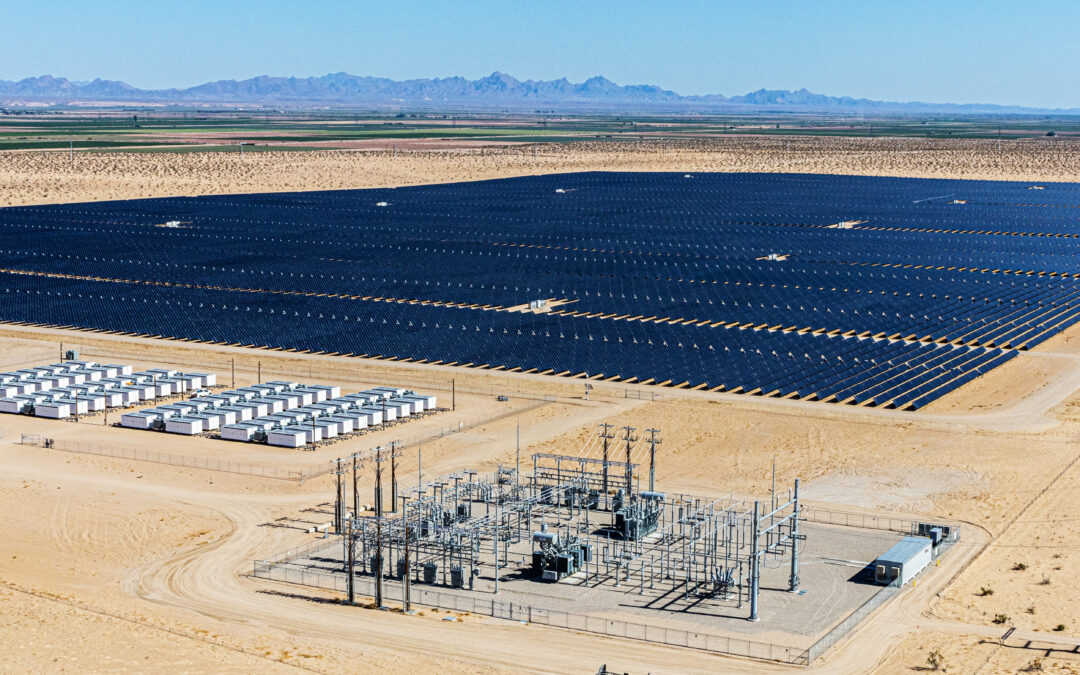By Sheldon Kimber, CEO, Intersect Power
When I was growing up, I loved computers and data networking. I built PCs on my own from scavenged parts. With the money from my first real jobs, I shopped endlessly through the pages of Computer Shopper magazine, a publication that looked like a phonebook, for the latest 386 and 486 processors, hard drives, memory, and video cards. These personal revelations are not just a window into my romantic prospects in high school; they also give you a sense of the front-row seat that my generation has had to the rapid evolution of computing technology.
Now, some 30 years later, the hobbies and vocation of my youth are overlapping with my years of experience in the power industry in ways that shock many but should have been obvious to most. When I built my last computer, a couple of years ago with my kids, we used a 1,000-watt power supply! This was shocking to me when compared to the ~100-watt power supplies I built with 30 years ago. I assumed that Moore’s Law had somehow contained the power needs of computing as it squeezed more and more performance out of each generation of microprocessor.
As it turns out, computing has gotten a lot more energy-efficient due to technology innovations over the years. The problem is humanity’s use of computing power has grown even faster. With the advent of artificial intelligence (AI), which requires enormous amounts of computation, our hunger is only growing, and by extension, electricity usage is accelerating. What’s more, this realization comes at a time when the power industry is already short of the supply it needs to fuel increasing electrification and decarbonization in the face of climate change.
AI shines a light on a problem that data center customers and other owners of large-scale computing power have had for years. The world is electrifying, the power grid is broken, and fossil fuel sources of power are increasingly limited by policy, capital markets, and the scientific reality of climate change. Turns out the hobbies of my youth were on a collision course with the key trends and insights that underlie Intersect Power’s business today. Those insights result in a simple conclusion that I have written about for years now. Load will come to the location of clean generation and do so at an alarming rate over the next few decades.
Innovation Meets A Good Old-Fashioned Gold Rush
As a power guy my whole career, I think of AI relatively simplistically. I am in no way taking away from the complexity and innovation in the science of AI, but it seems that much of the innovation is open source. Many sophisticated language and other AI models are published for all to see, and intellectual property is broadly available in the academic domain. While there is likely an advantage to some of the more proprietary models, there are plenty of powerful ones that are accessible to all. It is the training of these models that produces the weights and, thus, the “intelligence” for each node in the network, in much the same way that a regression produces coefficients that specify relationships in much simpler statistical models.
So, in my very simplistic view, open-source intellectual property plus enormous troves of data plus purpose-built processors plus copious amounts of electricity equals ever more powerful models. It is a race underpinned by innovation but won through acquisition. Specifically, the acquisition of the precious commodities of a decarbonizing and digitalizing world – data, chips, and electricity. The winners in the space will, therefore, be those who control one or more of the above, and the race is on for those of us with at least one of these puzzle pieces to vertically integrate, partner, or sell, or buy the other pieces for ourselves.
The current frenzy is, in essence, a trillion-dollar game of Gin Rummy that will, at a minimum, redefine humanity’s interactions with the world’s vast computing and data resources. At its limit, it may have the potential to generate the first silicon-based consciousness.
Digital Infrastructure Becomes A “Power Play”
As I’ve written about in the past, this innovation in code and processing will have as its foundation an awful lot of steel and infrastructure. Here in the earthbound trenches of the AI wars, the digital infrastructure players that have owned fiber, cell phone towers, data centers, and other complex real estate development for decades face new rivals and partners in the form of electricity generators, rebooted crypto companies, and even their own customers. All of them are looking to speed deployment of the necessary infrastructure with a “power first” focus, which is a departure from years of data center siting strategy.
In its simplest articulation, a large load like a data center requires three things:
- Grid Interconnection: A load interconnection or the plug that allows you to physically take enough power from the grid to meet the data center’s need. This element is increasingly the limitation on the speed with which a data center can come online. Long queues for generation and interconnection are overwhelming utilities.
- Abundant Electricity: Enough electricity on the system at the right time of day so that you can actually have energy reliably flowing from that plug in the quantities that the data center requires. This element is likely the limitation on the scale at which a data center can be deployed. Even with the ability to draw power at your point of interconnection, the delivery of energy over our aging grid is increasingly expensive and unreliable.
- Carbon-Free Energy Source: Ideally, enough renewable resources or storage assets on the grid to provide the energy from carbon-free sources at the same hours and in the same volumes as the data center is consuming.
To date, data center customers and developers have largely assumed that having grid interconnection was sufficient and that the grid and the power markets would provide for abundant and clean electricity eventually. It is now foolish to assume that even grid interconnection is available at the location and on the timeline data center customers require.
Data center developers and large tech companies have for years focused on siting for network effects with existing data center clusters, fiber availability, labor pools, and tax abatements while making the implicit assumption that local utilities would welcome them and their load growth with open arms. That was the case for many years, but it has recently been upended by four broad trends in electricity markets.
- The grid infrastructure for these new data center loads can be expensive and is usually socialized into the rate base such that all of the ratepayers bear some of its costs. This creates trade-offs between economic development and social equity and the associated political consequences.
- There is profitable load growth for many utilities in the build out of distribution and retail businesses to serve this electrifying residential and small commercial market.
- Policy and preference around decarbonization of the grid mean that there is a limited supply of clean energy to meet all of these demands, and new fossil generation is increasingly hard to build. Even in the face of rampant demand growth, capital markets will be loath to invest in 30+ year assets that may be technologically or environmentally stranded in the next decade or so.
- Finally, the grid is broken, and even in the wildest dreams of policymakers and transmission developers, there is likely not enough transmission capacity that gets built to solve the generation and load issues above. Never mind the interconnection queues clogged with the zombie projects that subject new data center loads and viable clean generation projects to years of delay.
High Capacity Factor, Low Cost, Clean Energy Is The Nexus Of Deep Decarbonization… and AI
If you’ve read my prior blogs, this should all sound pretty familiar. I’ve spent the better part of the last six years talking and writing about how the grid is broken and that industrial electrification of both existing industries, like steel, and new ones, like AI data centers and clean hydrogen, will require load to relocate alongside generation. In particular, locations with large amounts of high capacity factor, low-cost, clean electricity, such as the center of the country, will become ground zero for this reimagining of our energy infrastructure. Many of these regions can provide renewable energy for 60-70% of the hours of the year. With the use of battery storage and the gas that is often abundant in these same areas, projects can be easily firmed while maintaining percentages of carbon-free energy well in excess of grid power in most parts of the country. If the demand for AI is truly what they claim, this movement of load coming to clean generation will occur much faster and at a larger scale than I had previously imagined.
So, if a solution is so clear, why is it not underway? There is understandable hesitation around the wholesale upending of the electricity industry’s infrastructure and business model, but this is no different than similar technology-driven transitions.
Customers often resist the changes, holding out for products and solutions that are more familiar and more in line with their current way of doing business. In this current transition, the two best examples of this are the hesitance of the large data center customers to move away from their current hubs in places like Northern Virginia, Atlanta, Phoenix, Chicago, Dallas, Santa Clara and the reliance on RFPs and similar solicitations in an effort to exert the same level of control over suppliers as they have in the past.
The transition to “power first” data center siting will likely result in the need for new network infrastructure, the establishment of clusters in new geographic hubs, training, labor force development, and new technology solutions for things like water and backup power. In terms of commercial strategies, it is clear that the needs of AI data center customers are more varied and bespoke than ever before, and data centers with these new specifications will be in extremely short supply. Meanwhile, the power products they procure are more valuable and enabling than ever before. In this context, a commercial strategy reliant on control and commoditization of one’s supply chain is neither necessary nor likely to produce the rapid scaling of bespoke resources sought in the AI land grab. Deep partnerships, vertical integration, and strategic alliances across the providers of data, chips, and electricity will be the winning strategy in this marketplace. If AI is half of what the hype implies, the benefits of these changes in customer preference will be immense, but change is difficult no matter the prize.
The Temptation Of “Simple” Solutions That Require Less Change
The final obstacle to this transition is not so much a customer-specific issue but a very human problem that plagues all endeavors that require the reimagining of an entrenched way of doing things. The tendency to seek out the all-encompassing panacea that allows you to continue with minimal change is currently taking hold of customers, regulators, technology companies, and generators. In this case, the favorite panacea is nuclear power or new baseload combined cycle gas generation (CCGT). Building a data center behind or at the meter of an existing or new nuclear or CCGT power plant is seen as a means of potentially staying in the same geographies that data center customers currently desire while providing for this explosion of electricity demand.
I am certainly not opposed to this strategy nor to new nuclear or gas generation. In fact, I am a strong and public proponent of both. Moreover, these two approaches will almost certainly be part of the solution. All that said, they are some of the least scalable, longest-dated, and most regulatorily and environmentally challenging of all possible solutions. The fact that we would go here first is baffling to me and I don’t think I’m alone.
I was recently at an event where a senior business leader with no stake in AI or electric generation, after listening attentively to an extended discussion of nuclear-powered data centers, chimed in with a sentiment very similar to my own. He began with the same disclaimers I have above, that I am not an expert in AI, but a mere mortal of the energy business. Then he went on to make the observation that if you want speed, scale, certainty, and maximum percentage of clean energy, why not just go to the spots with vast amounts of land, wind, solar, natural gas, and the accompanying geologic formations that could accommodate carbon capture and storage, of which there are many in the center of this country. It’s the obvious solution and likely the only one that can achieve the scale necessary to support AI, if it does in fact turn out to be as massive as the hype suggests. However, it is also the one that requires the most change and the strongest resistance to the temptation of non-scalable solutions. It will be truly ironic if the winners in the race to non-human intelligence are those who can overcome the all-too-human aversion to change.
At Intersect Power It’s Business As Usual
At Intersect Power, we are doing what we’ve done since our company was founded in 2016. We continue to build one of the largest developers and operators of grid-connected clean energy and storage assets in the country. Beyond this core business, we continue to lead the way on the development of multi-gigawatt behind-the-meter renewable energy resources with some of the highest capacity factor clean energy in the world. We have fully developed single projects capable of hosting loads as large as 3GW+ behind-the-meter. Several of these projects can come online by the end of 2026, and most, if not all of them, can be online by 2029. Many of these were initially developed with a hydrogen thesis in mind but are just as appropriate for data centers, clean steel, direct air capture, and other large loads fleeing today’s overburdened grid.
As the megatrends of decarbonization, digitalization, and electrification collide, load is coming to clean generation. Whether it’s the stop-start of clean hydrogen, or the go, go, go of AI data centers, whether it’s today or five years from now, such change is inevitable.


